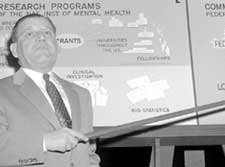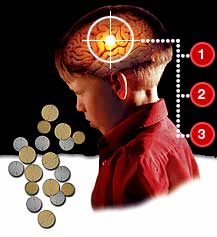The Scandal of ‘Kiddie Coke’
How educators were sold the scientifically bankrupt “chemical imbalance” theory, which opened America’s school doors to “poor man’s coke” (methylphenidate) and other “legal” drugsMost children and most parents do not know that the U.S. Drug Enforcement Administration (DEA) has warned that the drug methylphenidate — which addicts have termed “poor man’s coke,” but which is widely prescribed to schoolchildren to “control” behavior — can cause psychotic episodes, heart attacks, strokes, violence, psychological dependence and sudden death.
Hardly any of them know that the psychiatric classifications which precede and accompany use of this behavior-modifying substance can disqualify them from a career in the Army, Navy, Air Force, Marines or Coast Guard.1
In testimony before Congress, Terrance Woodworth, deputy director of the DEA’s Office of Diversion Control, noted that the United States produces and consumes about 85 percent of the world’s production of methylphenidate.
“The DEA has observed a dramatic increase in the production and use of both methylphenidate and amphetamine,” he said. He revealed that methylphenidate production surged from 1,768 kilograms in 1990 to 14,957 kilograms in 2000, an 8.5-fold increase, while amphetamine production rose even more sharply, from 417 kilograms in 1990 to 9,007 in 2000 — an increase of more than 21 times.2
And while consumption of methylphenidate and amphetamine has exploded in schools, law enforcement authorities report that increasing numbers of students in middle school, high school and college use methylphenidate and other stimulants “just to get high.”3
The widespread presence of such powerful drugs in America’s schools and on its streets — when matched against rising crime and violence statistics — is one index that psychiatric “behavior control” has failed, at great expense to the taxpayer.
Fishing for a Foundation That Doesn’t Exist
 CREATING A PHARMACEUTICAL NIGHTMARE: Determined to sell their drug utopia to the American public, mid-20th century psychiatrists adapted the “chemical imbalance” theory to their favorite playground: the education system. Robert Felix, the National Institute of Mental Health’s first director (above) urged colleagues to integrate so-called “mental health services” into schools. In 1961, he formed the American College of Neuropsychopharmacology (ACNP), stacking it with veterans of CIA mind control experiments, such as Nathan Kline. Kline co-authored a 1967 ACNP report that gave behaviorists the “chemical imbalance” justification for drugging American schoolchildren. |
The answer was to establish in the minds of Americans the brain “chemical imbalance” theory of behavioral disorders. To accomplish the existence of something wholly without scientific basis, a leap in logic was needed.
Psychiatrists seized upon the results obtained in their extensive LSD experimentation, where they found they could create full-blown psychosis with tiny chemical doses of the drug.
As reported by author Robert Coughlan in the March 15, 1963, edition of Life magazine4, psychiatrists extrapolated that if such phenomena could be induced from a tiny amount, normal behavior must depend on extremely fine chemical balances.
Thus, they declared that if they could affect behavior by the introduction of a drug agent, therefore all aberrant behaviors and insanity must likewise be caused by tiny chemical imbalances. Interpreting this as “proving” that only a minute chemical balance separated the normal from the insane, they extrapolated, since they could create insanity with drugs, they could also “create” sanity by handling “chemical imbalances” with drugs.
Unfortunately, after decades of hype and promotion, only the first part of their “chemical imbalance” theory has been proven — and tragically so.
But seemingly unconcerned by the inherent and deadly flaws in their new unsubstantiated theory, psychiatrists and psychologists forged ahead with their plans for a future where lives would be controlled through drugs. And the focus of their long-range efforts was the control of the behavior of children.
In the same 1963 article, Coughlan reported on the “advancement” of psychology and psychiatry, highlighting the views of what it described as one of the most influential figures in American psychology, B.F. Skinner.
According to Coughlan, Skinner believed that human behavior “can and ought to be controlled by scientists” for “man merely has illusions that he possesses free-will and that actually all human behavior is caused by material events.... Consequently, expert scientists owe it to humanity to take charge of events and arrange things so that people behave in ways that is for their own good.”
“Manipulate ... with a Great Deal of Precision”
Coughlan viewed it as “extraordinary,” as would any rational person, that other psychologists agreed with Skinner’s basic premise: “that man is to a large degree controllable and science can and will ... manipulate his behaviors in many ways and with a great deal of precision.... Science does seem to be well on its way, for better or worse, with the means to shape a great part of his own thoughts, emotions, actions and hence, his earthly destiny.”
Skinner disclosed his concept for how this would be done: “In the not too distant future, the motivational and emotional conditions of normal daily life will probably be maintained at any desired level through the use of drugs.”
Another pivotal figure in this regard was psychiatrist Nathan Kline, an early president of the American College of Neuropsychopharmacology (ACNP), formed in 1961.
Kline participated in the Central Intelligence Agency’s MK ULTRA “mind control” project, which ran for years and included numerous subprojects that involved drugs, electric shock and other means to manipulate human behavior.
|
The Myth of Chemical Imbalance
As presented in countless illustrations in other news magazines, like the one below, the brain has been dissected, its parts labeled and analyzed while the public has been assailed with the latest theories of how the physical and chemical disposition of the brain determines behavior, mental disorders or disabilities. What is missing, in all the psychiatric pontificating, is scientific fact. |
|

|
1 “[T]here are no tests available for assessing the chemical status of a living person’s brain.” Also, no “biochemical, anatomical or functional signs have been found that reliably distinguish the brains of mental patients.” — Biopsychologist Elliot S. Valenstein, Ph.D.
2 “[N]ot one [biochemical explanation for psychiatric conditions] has been proven. Quite the contrary. In every instance where such an imbalance was thought to have been found, it was later proven false.” — Joseph Glenmullen, M.D., Harvard psychiatrist 3 “There is no blood or other biological test to ascertain the presence or absence of a mental illness, as there is for most bodily diseases. If such a test were developed, then the condition would cease to be a mental illness and would be classified, instead, as a symptom of a bodily disease.” — Thomas Szasz, M.D., professor of psychiatry emeritus
|

